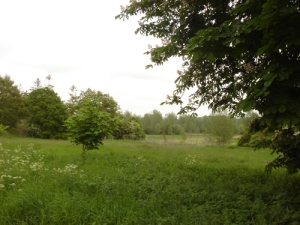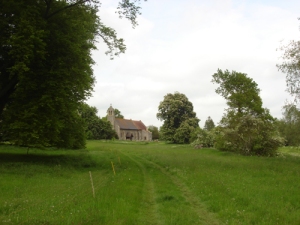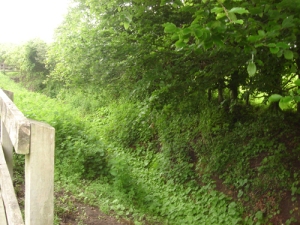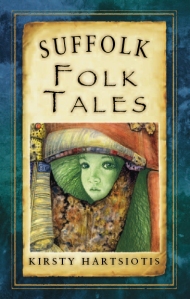On the way back from my book signing in Bury, which is a fair way from where my parents live near the coast, I wanted to visit one of the very few locations I hadn’t yet reached: Langham. Half of the Malekin story is set there, but I’d never, ever been there. The story is one that combines two small, remote places that make you feel as if you have stepped far away from the beaten track and into that deeper Suffolk that is inhabited by the stories of place I have captured in the book – and, it feels, by the denizens of the stories, too. The other half of the story is set in Dagworth, about 8 miles away as the crow flies to the south east of Langham. Both are tricky to get to – Langham especially if you don’t happen to have the 1:50 map on you at the time, as we did not.
In Malekin, the child says she came from Langham (or Lanaham in the original Latin), where she was ‘stolen by some stranger and taken away’ when she was left alone outside while her mother was working at the harvest with the rest of the villagers. It seems highly likely that this is an early version of a changeling – this time, following the child snatched by the fairies, or, in Suffolk, ferishers or feriers. More often, the story follows the fairy changeling that is left in place, but this tale tells what happens next to those who are taken off to fairyland – and it isn’t very pleasant or easy. There are tales told in Suffolk of fairy changelings, too. The same woman who recounts to the Reverend Arthur Hollingsworth the story of her own near miss with the fairies also says that she had heard of a woman who ‘had a child changed, and one, a poor thing, left in his place, but she was very kind to it, and every morning on getting up she found a small piece of money in her pocket.’[1] So, it seemed to me that this might be an ancient practice amongst the ferishers to reward the good – and why not reward Malekin’s mother as well, for the loss of her little girl and the gaining of another, different child.
But Langham has another mysterious link, one that I discovered by chance in Mike Burgess’s excellent website, Hidden East Anglia. It isn’t even listed under Langham in his gazeteer, but under nearby Hunston. This place, Burgess records, has a small earthwork called Mill Hill (a castle – or the site of a windmill – or even a more ancient burial mound?) from which it is said tunnels run to Great Ashfield Castle – and the Castle Ditches at Langham.
Now, England is criss-crossed with secret tunnels and Suffolk has many: from those that run from the Angel to the Abbey at Bury, to the tunnel that run from the church to the Queen’s Head at Blyford. Many of these tunnel stories have practical origins – drainage ditches at Bury, perhaps, and smuggler’s hideaways near the coast. But what if those tunnels went … somewhere else? The most famous tunnel story in Suffolk is that of the Green Children, who emerge near Woolpit from a tunnel from another land. Is it fairyland – or maybe the underworld itself? Once, a fiddler was lost forever in the tunnels at Bury, the ghostly notes still sometimes heard. A farmer lost his pigs into the tunnels at Hunston – and there is no record that they popped out at Great Ashfield or Langham. Perhaps the ferishers came out of the Castle Ditches tunnel to nab Malekin, and perhaps it is through the tunnels that she make her way around the county to steal food from humankind. Perhaps.
But I wanted to see. There is little info on the Castle Ditches on the web that I could find, just a note that they were east of the church, and that they are no longer visible. Oh well. We were determined to try. Without the 1:50 map we were a little stymied, but after a lot of dodging about to get a mobile signal I found the info about them being near the church. We backtracked through the long village (yep, still lives up to its name) to the edge of the village and down the path that alleged it led to the church. The path said PRIVATE in large letters, but did seem to be okay for walkers, so off we set, Cherry and I hobbling along in the pumps we had worn to Bury, and Dave limping on the track thanks to his dodgy knee. To the left was a little strip of wood – a remnant perhaps of what the land must have been like when people named Great Ashfield, Elmswell, Oaktree Farm and Willow Wood nearby – and huge oak tree stood like a guardian spirit from the past to the side of the path to welcome us in. Ahead, we could see water meadows by the stream that separates Langham from Hunston. There were sheep grazing, and Queen Anne’s Lace blooming. Idyllic. But not, immediately, a church.
A turn of the corner onto a grassier track, and there it was. A small flint church with a little bell tower. A tractor was dancing back and forth obliterating the long grass ahead of us, and the Hall stood imposing in 18th century brick to the left on higher ground. It was a vision (except for the tractor!) of an earlier time. However, the 21st century intruded not only in the tractor’s noise. The church was locked. And to spite us, a sign informed us that the very next day there would be an open day at Langham Hall and a service in the church. The tractor was creating a car park for the massed hordes…
Round the church we went, to the east – and higher ground. Was there something in that thicket of brambles? We investigated the edges of the churchyard and found – a moat! With a, um, bridge. I hacked through the nettles (if you run through them quickly, they don’t sting, right?) but decided not to cross…
Then we took the path in front of the church. It was clear where the castle ditches had been – two lovely flat horse paddocks now stood next to the church. But the ground slipped away sharply to the right of the path, and we glimpsed water through the gaps in the trees. The moat again! The castle was here – so somewhere must have been the entrance to the tunnels. Was it near here that Malekin was stolen back when this was a fine timber castle? Were they harvesting hay from the meadows beyond, and did the mother leave her babe safe close by the castle only to have the ferishers slip out and take her away?
 <
<
 &
&


[1] Gurdon, Eveline Gurdon County Folk-Lore Suffolk: Printed Extracts No. 2 Suffolk (Lightening Source UK Ltd., Milton Keynes, 2011), p. 37, taken from Revd AGH Hollingsworth’s The History of Stowmarket, 1844, p. 248


